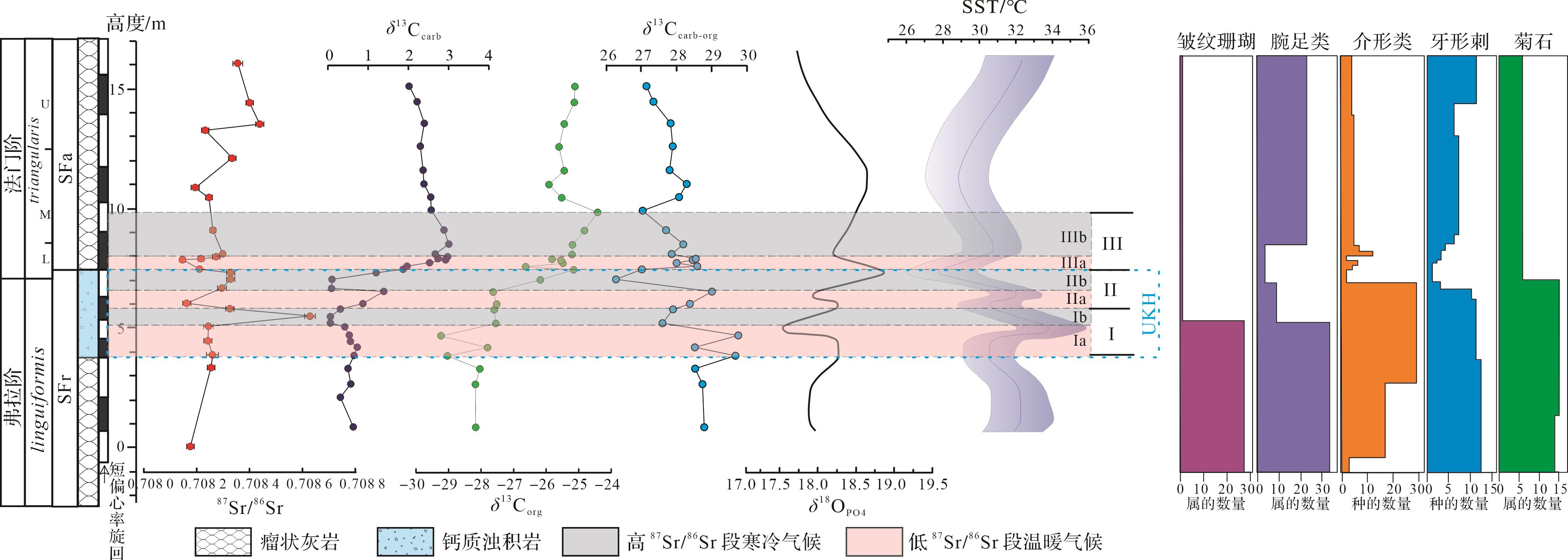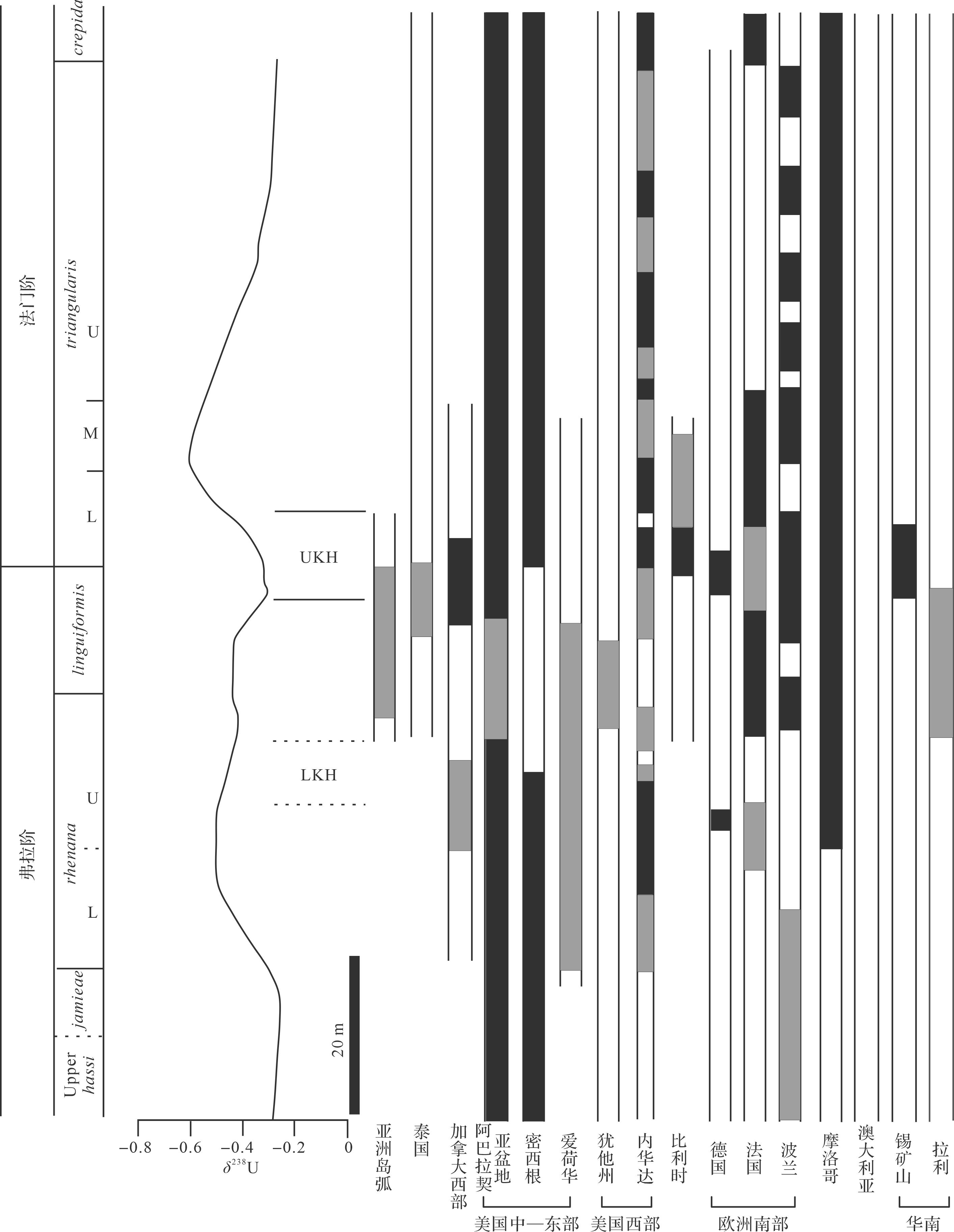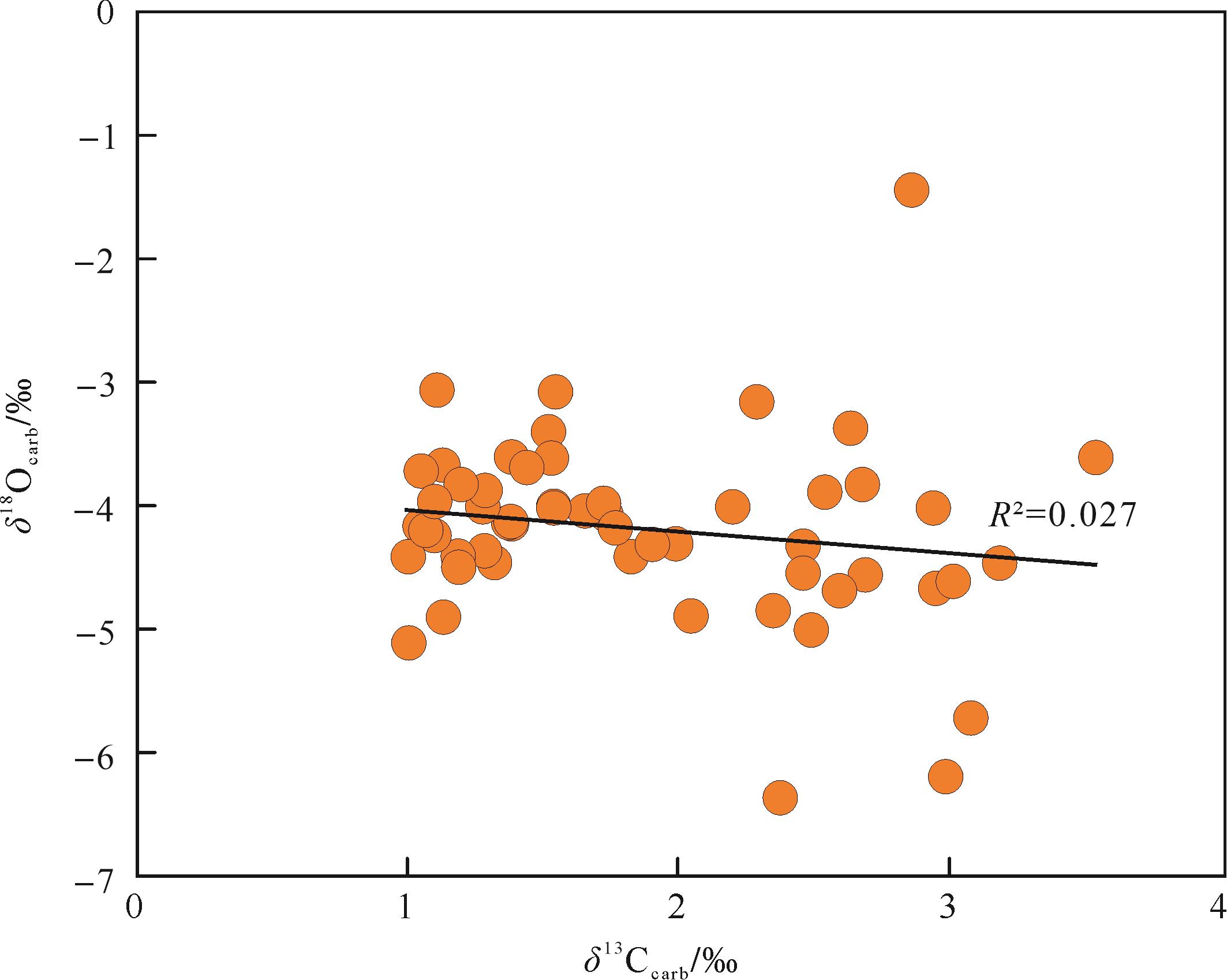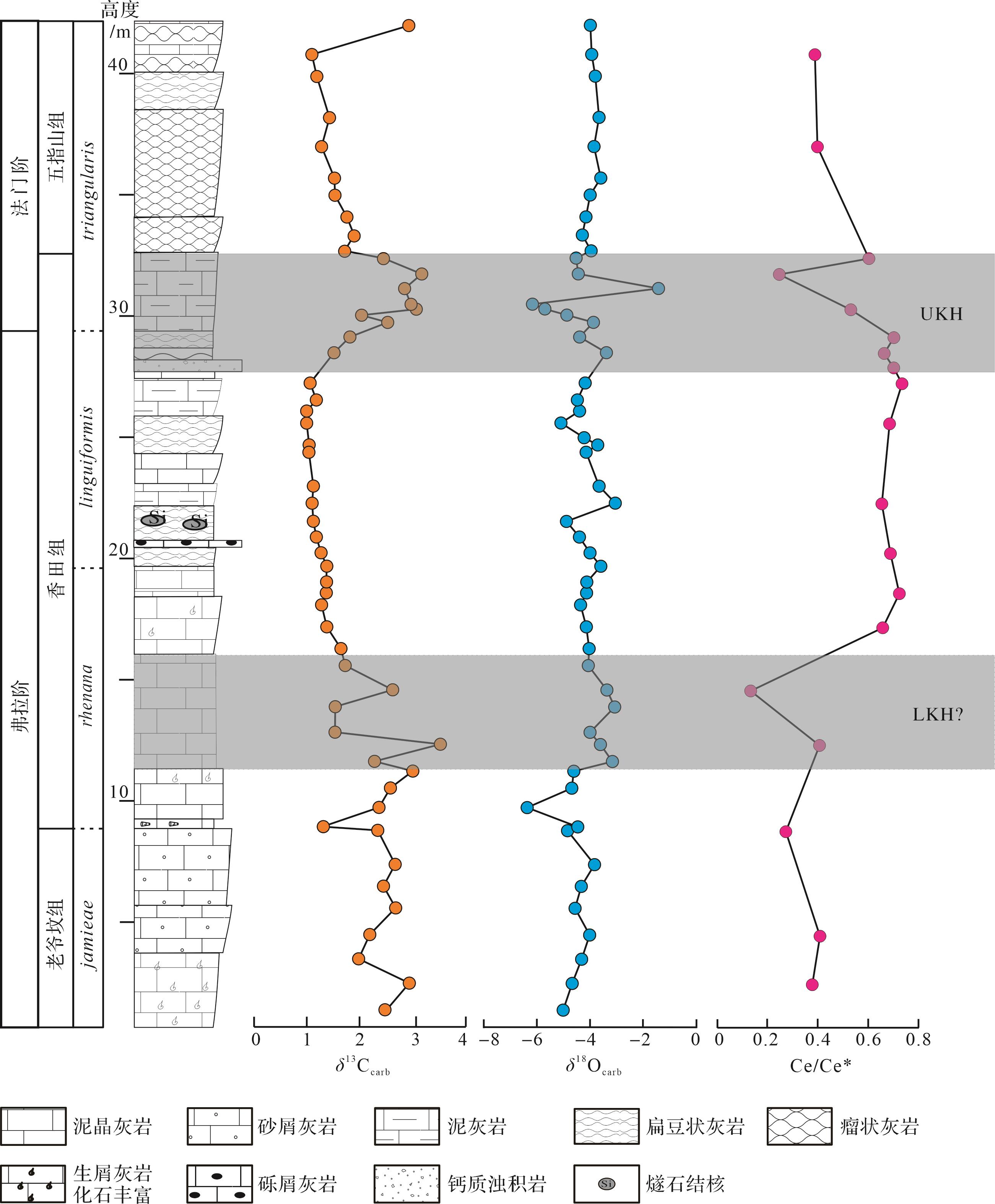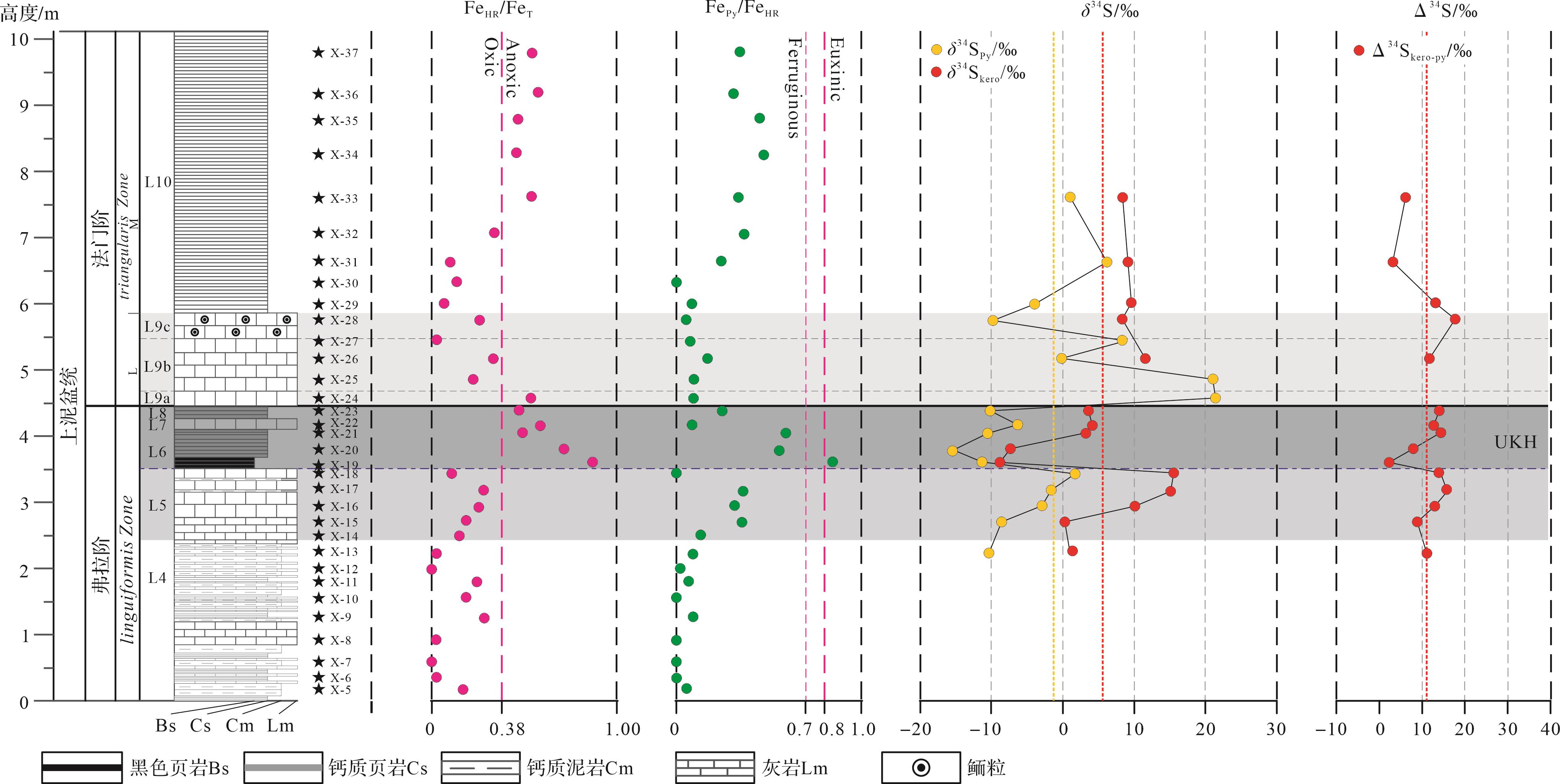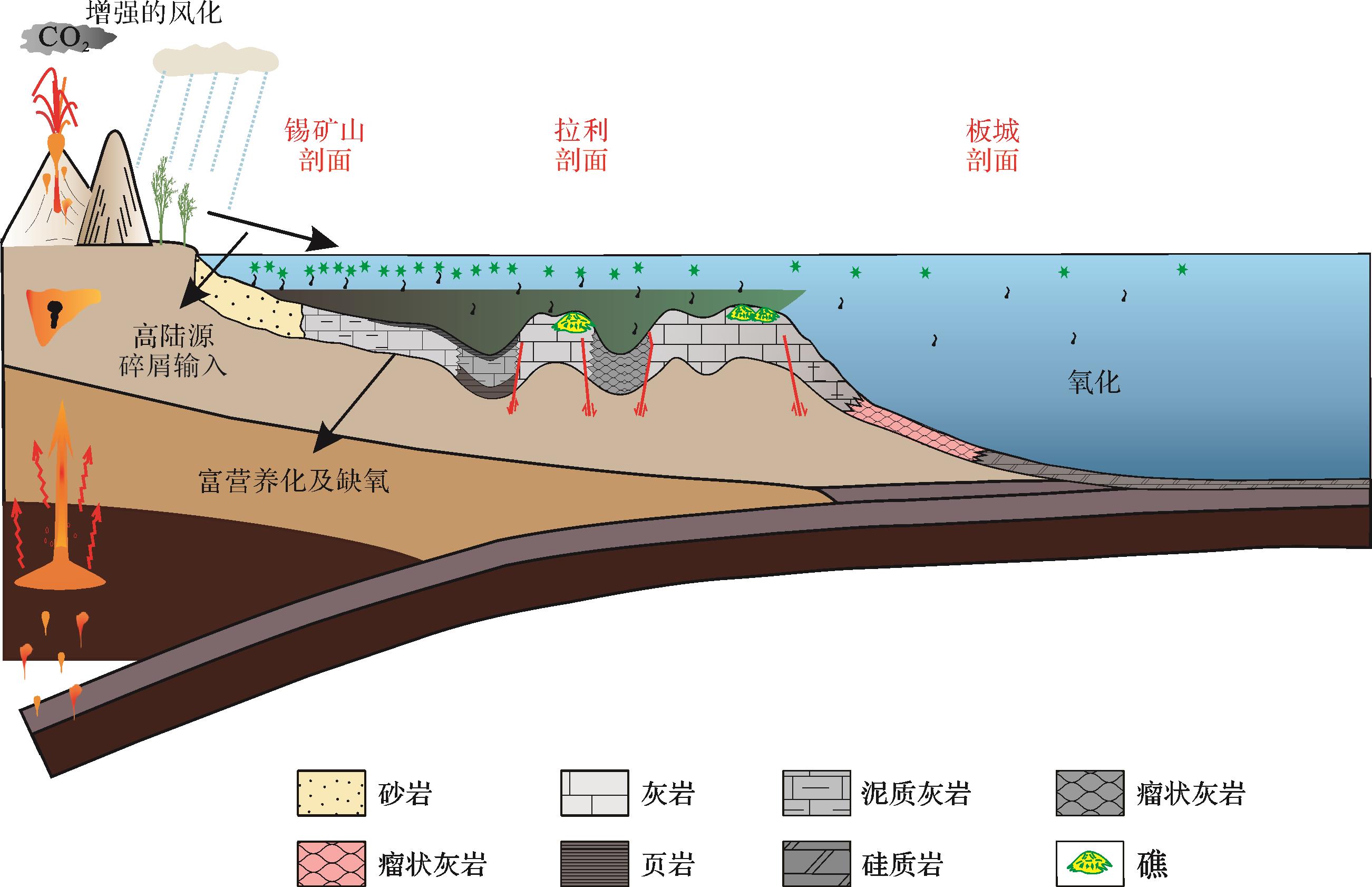HTML
-
泥盆纪晚期是地质历史关键时期,地球表生系统发生了显著变化,期间发生了诸如维管束植物登陆[1]、大陆风化作用增强[2⁃3]、全球气候由温室转变为冰室[4⁃6]、火山活动[7⁃9]、生物灭绝等重大地质事件[10⁃14]。其中,以晚泥盆世弗拉—法门(Frasnian-Famennian,F-F)转折期的生物灭绝事件最为显著,被称为F-F事件或者Kellwasser事件(可细分为上Kellwasser事件和下Kellwasser事件,分别位于牙形刺Palmatolepisrhenana带下部和Palmatolepis linguiformis带顶部),也被认定为显生宙五大生物集群灭绝事件之一[15⁃18]。
F-F生物灭绝事件实际上是一次循序的、渐进式生物灭亡的结果,从中泥盆世拉开序幕,在F-F界线附近达到顶峰(主幕)[19]。此次事件造成约21%科,50%属和80%种发生了灭绝[10,20],其中低纬度浅海底栖生物受到的影响最大,高纬度、深海生物和陆地生物所受影响甚微[18,21]。泥盆纪典型的珊瑚—层孔虫礁几乎全部消亡,世界范围内,47个浅水型四射珊瑚属仅2~3个属残存下来,而151个种的珊瑚几乎全部灭绝[19,22⁃23]。层孔虫属的数量急剧减少,35个属中24个属灭绝,灭绝率高达68%[24⁃25];腕足动物也受到重创,五房贝目和无洞贝目灭绝,正形贝目和扭月贝目受到重创,71个弗拉期的属仅10属存活下来,损失率约为86%,继之以法门期长身贝目、石燕贝目和小嘴贝目繁盛为特征[25];三叶虫5个目中3个目消失,6个科的分子消失,目一级灭绝率达60%[25];浅海底栖介形类世界各地灭绝强度有所差异,种一级的灭绝率介于65%~80%[26],深水介形类受影响较弱;大量弗拉期典型牙形刺分子消亡,全球范围内弗拉阶顶部的Palmatolepid生物相、Palmatolepid⁃Polygnathid生物相转变为法门阶底部的Palmatolepid⁃Icriodid生物相[27]。竹节石几乎全部灭绝,25个属仅有3个属的个别分子延续至法门期早期[28];菊石约67%的属,88%的种灭绝[29]。深水放射虫影响很小,并在灭绝事件之后有上升的趋势[21]。
关于此次生物危机的成因机制,大量学者通过沉积学、地球化学等手段进行了探讨,主要包括海平面变化[30⁃31]、海洋缺氧及富营养化[32⁃36]、气候变化[27,37⁃38]、火山(热液)活动[8⁃9]以及地外事件[12,39]等。通过Web of Science以Late Devonian mass extinction(晚泥盆生物灭绝)和Frasnian-Famennian(弗拉—法门转折期)为关键词检索了2000—2023年文献,显示气候变化和海洋缺氧是目前认可度和讨论度(被引率)最高的假说,且越来越多的证据表明各环境要素之间相互影响与制约。在F-F转折期,古气候与古海洋环境具备怎样的特征,不同环境要素之间如何协同变化,以及导致F-F生物危机的最核心因素是什么,都是值得总结和探讨的科学问题,也对理解这一时期地球环境—生命协同演化规律具有重要意义。
拟通过对F-F转折期气候、古海洋环境变化的研究现状进行系统梳理,并结合华南的最新研究成果,详细论述F-F转折期的古气候演化规律、古海洋氧化还原结构以及最可能的生物灭绝机制,以期为下一步的研究提供思路。
-
晚泥盆世古地理的基本格局主要由冈瓦纳古陆、劳伦西亚大陆及其间的古特提斯洋、泛大洋组成。劳伦西亚大陆以东由一些分散的大型陆块或小型至微型陆地群组成,其中,以西伯利亚、哈萨克斯坦、中国华北和华南古陆较大。冈瓦纳大陆主体位于30° S以南,劳伦西亚大陆、华南板块、华北板块、塔里木板块和哈萨克斯坦板块主体位于赤道附近(南北纬30°之间)(图1)。劳伦西亚大陆中央为南北向的加里东造山带隆起区,东西两侧发育广阔陆表海。冈瓦纳古陆为广大隆起区,北缘发育宽阔陆表海。劳伦西亚大陆东南缘与冈瓦纳大陆西北缘之间以狭窄的瑞亚克洋相隔。华南板块由华夏和扬子地块拼合而成,主体为隆升剥蚀区,周缘主要为陆表海[40]。

Figure 1. Global paleogeographic map and main study areas of Frasnian⁃Famennian (F⁃F) events in the Late Devonian (modified from reference [38])
全球范围内,F-F事件的研究区主要集中在瑞亚克洋周缘水体受限的构造盆地、华力西—阿巴拉契亚一带的陆表盆地、陆缘盆地和华南的沉积盆地中,主要包括当时低纬度地区的欧洲各地、北美东部和华南地区,研究内容包括古生物、沉积学、地层学、地球化学等方面[25](图1)。
拉利剖面位于广西壮族自治区宜州市,上泥盆统由老至新可划分为老爷坟组、香田组和五指山组。老爷坟组以灰色中厚层生屑灰岩、砂屑灰岩为主,香田组以浅灰—深灰中薄层泥晶灰岩,泥质条带灰岩和扁豆状灰岩为主,五指山组主要为深灰色薄层—中层瘤状灰岩、扁豆状灰岩。针对不同岩性系统采集了拉利F-F界线剖面新鲜岩样,对其中55件样品进行了碳氧同位素分析,19件样品进行了稀土元素分析。碳氧同位素与稀土元素分析分别在中国科学院地质与地球物理研究所(IGGCAS)稳定同位素地球化学实验室和成矿年代学实验室完成。碳同位素和氧同位素的精度分别高于0.20‰和0.15‰。稀土元素测试误差小于10%。
-
每种生物都有其最适宜的生存温度区间,小幅度的气温变化也可能对F-F事件中受影响最甚的低纬度(南北纬30°之间)浅海底栖生物种群产生致命的打击。F-F转折期,气候变暖和变冷的假说都有支持者。早期有学者提出F-F之交的海水温度可达40 ℃,温度的升高可能造成F-F生物危机[41]。然而更多证据表明弗拉晚期温度较高,存在一个“温室”气候,F-F转折期,气候变冷,逐渐向“冰室”转化[4,37,42]。
Streel et al.[4]根据孢粉组合的分类多样性研究,认为吉维特期和弗拉期温度较高并在弗拉末期达到最高;法门早期,孢粉多样性下降,表明F-F转折期气候变冷。北美(加拿大)、华南(广西)在F-F界线之下发育的因海平面下降造成的碳酸盐台地暴露/岩溶作用[4,33,43]亦被认为是F-F转折期气候变冷的重要证据。此外,氧、碳、锶等同位素更为精细地刻画了F-F转折期的气候变化。
Joachimski et al.[37]对德国Rheinische Schieferge birge地区的两条F-F界线剖面进行了牙形刺氧同位素(δ18OPO4)分析,结果显示上、下Kellwasser层(Upper/Lower Kellwasser Horizons,即UKH和LKH)δ18OPO4值出现了+1‰~+1.5‰(VSMOW)的正偏移,由此计算出F-F转折期海水温度大致下降了5 ℃~7 ℃。之后,他又分析了欧洲、北美、澳大利亚的多条泥盆纪剖面的牙形刺氧同位素,结果表明,从早泥盆世的布拉格期(Pragian)到中泥盆世的吉维特(Givetian)中期,温度逐渐从30 ℃下降至22 ℃;从吉维特(Givetian)中期到晚泥盆世的弗拉(Frasnian)晚期,温度又逐渐上升至30 ℃;在弗拉期和法门期之交,温度小幅降低[6]。类似地,Le Houedec et al.[44]使用牙形刺氧同位素温度计在法国和摩洛哥的F-F界线剖面中也识别到弗拉期和法门期之交的小幅降温事件。由于欧洲、北美等地很多深水F-F界线剖面高度凝缩[45⁃46],高分辨率的地球化学和环境信号可能存在缺失或叠加,华南F-F剖面一般是欧洲同期剖面厚度的2~5倍,沉积速率适中,能更好地保存当时的海洋环境信息。Huang et al.[27]和Zhang et al.[47]对华南的付合(杨堤)和拉利F-F界线剖面进行了高精度的牙形刺氧同位素分析,结果显示F-F之交海水温度变化范围为27 ℃~36 ℃,与欧美地区接近,LKH-UKH存在明显的快速降温事件。特别地,付合(杨堤)剖面海水温度在F-F转折期有多次短周期的暖—冷交替波动,而非单调下降。
除氧同位素外,碳(δ13C)和锶同位素(87Sr/86Sr)也是极好的古气候指标。F-F事件中,δ13C值在UKH-LKH出现了全球性的碳同位素正偏移,幅度+2‰~+4‰[48⁃49],此次正偏移一般被认为是有机碳快速埋藏的结果,伴随着全球大气CO2分压(pCO2)的下降和气候的变冷[19,48⁃50]。此外,有研究认为碳酸盐岩的无机碳(Ccarb)和有机碳(Corg)同位素差值δ13Ccarb-org不仅仅代表了不同碳库中初始同位素组成,更代表了固定CO2过程中初级生产者(浮游植物)与海水溶解的CO2以及pCO2之间的碳同位素分馏效应(εp)。当pCO2升高时(气温升高)时,分馏作用增强,δ13Ccarb-org值升高,反之亦然[48,51⁃54]。华南付合(杨堤)剖面碳同位素结果显示F-F之交δ13Ccarb-org整体下降,且中间存在3次明显的波动旋回[8],波动趋势与该剖面的δ18OPO4结果刚好相反[38](图2),进一步证实了F-F转折期的气候在整体变冷的趋势下存在多期暖—冷交替。因此,气候的整体变冷与风化作用的长期效应和有机碳快速埋藏有关。

Figure 2. Comparison of biodiversity and 87Sr/86Sr, δ13Ccarb, δ13Corg, δ13Ccarb⁃org, δ18OPO4 and sea⁃surface temperature (SST) data at Fuhe section during F⁃F transition (modified from references [27,38])
海水的锶同位素组成(87Sr/86Srsw)主要由“壳源锶”和“幔源锶”的相对输入量及其同位素比值决定[55⁃56]。全球海水87Sr/86Sr值曲线显示从中泥盆世吉维特晚期到晚泥盆世弗拉早期,海水87Sr/86Sr值呈上升趋势,这可能是Eovariscan造山运动引起的地壳抬升和大陆风化作用增强导致[2,57]。此外,Algeo et al.[58]提出中泥盆世维管束植物向陆的快速扩张可能引起硅酸盐风化作用增强。然而,这种长周期的风化作用增强是无法解释F-F转折期的气候快速变化的。Zhang et al.[38]对F-F转折期华南付合剖面和波兰Kowala剖面进行了高精度的牙形刺87Sr/86Sr值分析,在F-F转折期发现了三次明显的87Sr/86Sr值波动(特别是付合剖面,图2中阶段I,II,III),每次波动(~200 kyr)对应着87Sr/86Sr值从小(负偏移)到大(正偏移)的变化,且与碳—氧同位素有着极好的对应关系:87Sr/86Sr值降低(负偏移)时,δ13Ccarb-org增大(正偏移),δ18OPO4减小(负偏移),反之亦然(图2)。对此,Zhang et al.[38]认为小规模的火山放气作用会向大气中释放大量温室气体,气候变暖,水循环加速,δ13Ccarb-org值增大,δ18OPO4值减小,陆地风化作用增强,引起陆源锶通过河流输入至海洋,87Sr/86Sr值增大;随着风化作用消耗掉大气CO2,pCO2降低,气候逐渐变冷,δ13Ccarb-org值变小,δ18OPO4值增大,87Sr/86Sr值减小。因此,间歇性、短周期的火山放气作用引起的风化作用变化和气候暖—冷交替导致了F-F转折期频繁的C-O-Sr同位素变化。
综上所述,中泥盆吉维特晚期—晚泥盆世弗拉晚期,气候逐渐升温;弗拉末期,温度达到最高;弗拉末期—法门早期(F⁃F转折期),气候整体变冷,但中间存在多次暖—冷交替。频繁、短周期的火山放气作用引起的风化作用变化可能是该时期气候暖—冷交替的根本原因。
-
氧气是生物赖以生存的基本条件,从地球出现原始生命后,生物经历了从简单到复杂、从低等到高等、从水生到陆生的演化,这都与大气和海洋氧含量的增长密不可分。大多数F⁃F界线剖面的UKH,LKH层以特征性的沥青质灰岩和黑色页岩沉积为主[33,59⁃60],因此海洋缺氧导致了F⁃F生物危机的假说经久不衰。
-
欧洲、北美地区的多条F⁃F界线剖面在UKH层识别到粒径较小且变化范围狭窄的草莓状黄铁矿,指示了UKH层的缺氧事件,但LKH层缺氧信号较弱[33,61]。Mn-Mo-U-V等氧化还原敏感元素在部分欧洲、北美剖面的UKH和LKH层有较明显的富集,指示了缺氧事件的存在[35,60]。Haddad et al.[62]对北美Appalachian盆地UKH层的高分辨率微量元素分析认为UKH层内的缺氧是间歇性存在,并非持续缺氧。此外,氮同位素(δ15Norg)在Kellwasser层的正偏移[35]、碳酸盐晶格硫酸盐和黄铁矿的硫同位素(SCAS,SPy)在UKH的波动[8,63],营厌氧光合作用的绿硫细菌生物标志化合物的出现[34,64]均证实了Kellwasser缺氧事件,特别是在UKH层,有明显的缺氧甚至硫化。
然而,绝大多数的研究剖面都出现在特定的环境中,特别是靠近物源的陆表海、陆缘海盆地[65]。相反,部分离岸的、高纬度地区的F⁃F剖面中则缺乏明显缺氧记录[66⁃67]。此外,以上指标大多仅代表了局部或者区域性的缺氧事件,对全球性海水缺氧的指示意义不强。
近年来,U同位素(δ238U)不断被用于全球海洋缺氧面积的定量研究[68⁃70]。学者对来自美国内华达Devil’s Gate组[36]和我国广西白沙剖面[71]的碳酸盐岩进行了δ238U分析,结果显示UKH和LKH层附近(与UKH、LKH层不完全对应)均出现了δ238U负偏移,并由此(根据质量平衡模型)计算出全球海洋底层水体的缺氧面积增加了5%~15%,且总体海洋缺氧面积小于20%。White et al.[36]同时指出,缺氧海水主要集中在亚热带地区的陆缘海UKH和LKH层,缺氧面积分别为~45%(LKH)和~79%(UKH);但缺氧事件不仅仅局限于Kellwasser层,延伸范围可能更广(例如从牙形刺Hassi带到Crepida带均出现),且各研究剖面之间的缺氧程度和出现位置差异较大(图3)。不难看出,F-F转折期的海洋缺氧事件在一定程度上是“局限”的,主要集中在低纬度靠近陆源的陆表海/陆缘海,深海则不缺氧。缺氧事件在UKH层达到顶峰,但在UKH层内仍然是间歇性缺氧;LKH层缺氧信号较弱,以次氧—氧化为主。

Figure 3. Comparison of marine anoxia in different regions of the Earth in the Late Devonian (modified from
reference [36]) -
针对Kellwasser缺氧事件,目前有两种模型:(1)“由下至上型”,即深层缺氧水体的上涌引起缺氧;(2)“由上至下型”,即大陆风化作用增强向海洋输入大量营养物质,导致富营养化和缺氧[33,35,65,73]。
-
拉利剖面的碳酸盐岩碳氧同位素(δ13Ccarb, δ18Ocarb)和稀土元素分析结果详见表1和表2。δ13Ccarb值介于+0.99‰~+3.53‰(VPDB)。δ18Ocarb值介于-1.45‰~-6.37‰(VPDB),平均值为-4.19‰VPDB(n=55)。垂向上,碳同位素发生了两次明显的正偏移。第一次正偏移发生在香田组底部,LKH层附近,δ13Ccarb值由1.06‰(LL-41)增长到3.53‰(LL-46),增幅2.22‰。第二次正偏移发生在F-F界线附近,即UKH层,δ13Ccarb值由0.28‰(LL-68)增长到3.17‰(LL-77),增幅为2.89‰。Y/Ho比值介于33.48~54.42,平均值为42.34(n=19)。Ce/Ce*(Ce/Ce*=2Cen/(Lan+Prn)值介于0.13~0.73,变化范围较大,平均值为0.53(n=19)。
样品编号 高度/m δ13Ccarb‰ δ18Ocarb‰ 样品编号 高度/m δ13Ccarb‰ δ18Ocarb‰ 样品编号 高度/m δ13Ccarb‰ δ18Ocarb‰ LL-33 1.40 2.48 -5.01 LL-52 17.20 1.37 -4.15 LL-71 29.15 1.82 -4.41 LL-34 2.50 2.94 -4.67 LL-53 18.10 1.28 -4.36 LL-72 29.75 2.53 -3.89 LL-35 3.50 1.98 -4.31 LL-54 18.60 1.36 -4.14 LL-73 30.05 2.04 -4.89 LL-36 4.50 2.19 -4.01 LL-55 19.05 1.37 -4.13 LL-74 30.30 3.07 -5.72 LL-37 5.60 2.68 -4.56 LL-56 19.70 1.37 -3.61 LL-75 30.50 2.98 -6.19 LL-38 6.50 2.45 -4.33 LL-57 20.25 1.27 -4.01 LL-76 31.15 2.85 -1.45 LL-39 7.40 2.67 -3.83 LL-58 20.90 1.18 -4.41 LL-77 31.75 3.17 -4.47 LL-40 8.80 2.34 -4.85 LL-59 21.55 1.12 -4.90 LL-78 32.40 2.45 -4.55 LL-41 8.95 1.31 -4.46 LL-60 22.30 1.10 -3.06 LL-79 32.70 1.71 -3.98 LL-42 9.75 2.37 -6.37 LL-61 23.00 1.12 -3.67 LL-80 33.35 1.89 -4.31 LL-43 10.55 2.58 -4.69 LL-62 24.70 1.04 -3.72 LL-81 34.10 1.76 -4.18 LL-44 11.25 3.01 -4.61 LL-63 24.40 1.04 -4.17 LL-82 35.00 1.53 -4.02 LL-45 11.65 2.28 -3.16 LL-64 25.00 1.09 -4.24 LL-83 35.70 1.52 -3.62 LL-46 12.35 3.53 -3.61 LL-65 25.60 1.00 -5.11 LL-84 37.00 1.28 -3.88 LL-47 12.85 1.53 -4.01 LL-66 26.10 0.99 -4.41 LL-85 38.20 1.43 -3.69 LL-48 13.90 1.54 -3.08 LL-67 26.55 1.18 -4.50 LL-86 39.90 1.19 -3.83 LL-49 14.60 2.63 -3.37 LL-68 27.25 1.06 -4.20 LL-87 40.80 1.09 -3.97 LL-50 15.60 1.72 -4.07 LL-69 27.90 — — LL-88 42.00 2.93 -4.02 LL-51 16.30 1.64 -4.04 LL-70 28.50 1.51 -3.40 Table 1. δ13Ccarb and δ18Ocarb data at Lali section
样品编号 高度/m La Ce Pr Nd Sm Eu Gd Tb Dy Y Ho Er Tm Yb Lu Ce/Ce* Y/Ho ×10-6 LL-34 2.50 0.90 0.58 0.13 0.56 0.09 0.02 0.13 0.02 0.14 1.52 0.03 0.09 0.01 0.08 0.01 0.38 48.48 LL-36 4.50 2.30 1.64 0.35 1.46 0.26 0.06 0.32 0.05 0.34 3.19 0.07 0.20 0.03 0.19 0.03 0.41 43.38 LL-40 8.80 0.62 0.29 0.09 0.35 0.06 0.01 0.09 0.01 0.09 1.04 0.02 0.05 0.01 0.05 0.01 0.27 52.55 LL-46 12.35 3.04 2.41 0.60 2.51 0.49 0.09 0.49 0.08 0.50 4.08 0.11 0.29 0.04 0.26 0.04 0.41 38.55 LL-49 14.60 0.26 0.06 0.03 0.14 0.03 0.01 0.04 0 0.03 0.41 0.01 0.02 0 0.02 0 0.13 53.20 LL-52 17.20 4.38 5.17 0.72 3.21 0.60 0.13 0.74 0.11 0.66 5.43 0.14 0.39 0.05 0.32 0.06 0.66 37.70 LL-53 18.10 LL-54 18.60 7.44 9.56 1.20 4.69 0.84 0.22 1.03 0.17 1.06 8.72 0.23 0.65 0.09 0.62 0.11 0.72 37.58 LL-57 20.25 4.46 5.27 0.66 2.55 0.49 0.13 0.55 0.07 0.44 4.38 0.09 0.25 0.04 0.21 0.04 0.69 48.37 LL-60 22.30 3.48 3.73 0.45 1.86 0.35 0.08 0.44 0.07 0.54 4.87 0.13 0.38 0.06 0.36 0.06 0.65 38.40 LL-65 25.60 2.02 2.19 0.24 1.05 0.16 0.03 0.18 0.02 0.12 1.32 0.02 0.07 0.01 0.06 0.01 0.68 54.42 LL-68 27.25 0.87 1.09 0.13 0.49 0.09 0.02 0.10 0.01 0.09 0.77 0.02 0.06 0.01 0.05 0.01 0.73 39.47 LL-69 27.90 3.04 3.98 0.55 2.23 0.44 0.10 0.51 0.08 0.54 4.59 0.12 0.31 0.04 0.26 0.04 0.70 38.22 LL-70 28.50 2.73 3.50 0.53 2.16 0.38 0.08 0.44 0.07 0.45 3.39 0.10 0.26 0.04 0.23 0.04 0.66 34.76 LL-71 29.15 1.40 1.70 0.21 0.87 0.16 0.03 0.16 0.02 0.13 1.13 0.03 0.07 0.01 0.06 0.01 0.70 41.05 LL-74 30.30 1.61 1.50 0.25 0.97 0.18 0.03 0.18 0.03 0.21 1.85 0.05 0.15 0.02 0.14 0.03 0.53 37.49 LL-77 31.75 2.82 1.24 0.45 1.94 0.38 0.08 0.44 0.06 0.39 4.17 0.08 0.22 0.03 0.18 0.03 0.25 50.92 LL-78 32.40 5.28 6.20 1.05 4.41 0.77 0.15 0.80 0.11 0.67 5.41 0.14 0.35 0.04 0.28 0.04 0.60 39.64 LL-84 37.00 4.13 3.19 0.81 3.59 0.72 0.14 0.79 0.13 0.79 6.24 0.17 0.45 0.06 0.39 0.06 0.40 36.76 LL-87 40.80 5.92 4.70 1.30 5.52 1.06 0.24 1.17 0.19 1.20 8.60 0.26 0.68 0.10 0.59 0.09 0.39 33.48 注: Ce/Ce*=2Cen/(Lan+Prn),“n”代表PAAS。Table 2. REE data at Lali section
Y/Ho比值被广泛用于指示陆源输入量,后太古宙澳大利亚页岩(Post⁃Archean Australian Shale,PAAS)和现代海水的Y/Ho比值分别为~27和~44[74-75],拉利剖面19个灰岩样品的Y/Ho平均值为42.34,接近现代海水值,表明陆源碎屑混入量很少。此外,海相碳酸盐岩δ18Ocarb大于-5‰时,一般认为其基本不受成岩流体改造[76]。拉利剖面的除极个别样品δ18Ocarb大于-5‰外,其余样品的δ18Ocarb值均小于-5‰,且δ13Ccarb与δ18Ocarb之间相关性很低(R2=0.03,图4),说明拉利剖面的灰岩样品受成岩作用影响较小,较好地记录了当时的海水信号。
现代海洋中,Ce3+容易被锰(Mn)的氧化物或者细菌等氧化成Ce4+。Ce4+容易吸附在Mn氧化物或者氢氧化物的表面,从海水中清除。因此,相对于其他+3价的稀土元素(Rare Earth Element,REE),Ce在海水中的溶解度变低,导致氧化的海水亏损Ce,呈现Ce负异常;缺氧的海水Ce/Ce*值相对较高[77⁃78]。拉利剖面Ce/Ce*值介于0.13~0.73,平均值为0.53。垂向上,Ce/Ce*值在香田组顶部(F-F界线之下)瘤状灰岩、泥质灰岩段发生了明显增大(图5),由最小值0.13增长到最大值0.73,增幅达到0.60。因此,尽管拉利剖面碳酸盐岩Ce/Ce*值总体呈负异常,但垂向差异较大,在F⁃F界线之下(UKH层及其之下)海水变得更加还原;而LKH层Ce/Ce*较小,也没有明显的增大,表明LKH层并未发生明显的缺氧,类似于部分欧洲、北美剖面结果[33,36]。
-
Zhang et al.[46]曾通过氧化还原敏感元素对华南广西地区深水海槽相(与广海相连)的板城剖面(图6)进行了氧化还原状态研究,结果显示Mo、U和V元素在F⁃F界线附近没有富集,表明板城地区在UKH和LKH层及其附近沉积时海水没有出现缺氧,仍然保持氧化状态(图6)[46]。

Figure 6. Stratigraphic distributions of Mo, U, V concentrations and Mo/Al, U/Al, V/Al, Th/U ratios at Bancheng seetion during F⁃F transition (modified from reference [46])
Cai et al.[72]通过硫同位素和铁组分对华南近陆源的滨岸台地相的锡矿山剖面(图7)F-F转折期的缺氧事件进行了研究。结果显示,UKH事件层,FeHR/FeT大于0.38,FePy/FeHR升至0.88,有机硫(SKero)和黄铁矿硫(SPy)同位素值大幅负偏,∆34SKero-Py的快速减小(图7),海洋硫酸盐浓度大幅降低,表明海洋环境从氧化状态快速转变为缺氧硫化状态[72]。

Figure 7. Stratigraphic distributions of Fe speciation (FeHR/FeT, FePy/FeHR) and sulfur isotopes (δ34SKero, δ34SPy, δ34SKero-Py) at Xikuangshan during F⁃F transition (modified from reference [72])
综上,从锡矿山、拉利和板城剖面的研究成果来看,最靠近陆源、水体最浅的锡矿山剖面缺氧程度最高,UKH层缺氧硫化;相对远离大陆、水体较浅的台地边缘—斜坡相拉利剖面UKH层及其之下相对还原;而更加开阔、更深水、更加远离大陆的板城剖面持续氧化。由此可见,在华南地区,“由上至下”的缺氧模式更为合理(图8)。此外,晚泥盆世华南地区呈网格状、台地—台间盆地间隔的古地理格局,且海平面在F⁃F之交整体呈下降趋势[13,43],这在很大程度抑制了上升洋流,一定程度支持了大陆风化增强最终导致海水缺氧的模式。

Figure 8. Schematic diagram of marine redox states in southern China during F⁃F transition (modified from reference [46])
Carmichael et al.[79]关于晚泥盆世孤立岛弧环境的缺氧研究显示,晚泥盆世开阔海中岛弧两侧水体出现短暂缺氧;然而上升流,水体停滞以及热液活动引起的缺氧(即上升流模型)都不能很好地解释岛弧两侧水体缺氧现象[65]。此外,大量的研究证实该时期有明显的初级生产力增强以及透光带富营养化现象[32,34,50,62,64,67],因此风化作用增强引起输入海洋的陆源营养物质增加,导致近陆源的陆缘海地区的海水富营养化和缺氧的模式受到了更多学者的青睐。
3.1. 全球海水氧化还原状态
3.2. 华南地区海水氧化还原状态和缺氧模式
3.2.1. 拉利剖面氧化还原状态
3.2.2. 华南其他剖面氧化还原状态及缺氧模式
-
综上所述,F⁃F转折期,古气候、古海洋等环境要素发生了明显波动。各环境要素间存在一定的成因联系,它们对F⁃F转折期的生物演变有着不同程度的影响。
F⁃F转折期的气候变化与底栖生物为主的生物消亡有着较好的对应关系(图2),表明气候对于F⁃F生物危机有着直接且深刻的影响。F⁃F转折期的缺氧事件的出现时间、程度在世界各地表现不一(图3),很难直接将海洋缺氧与F⁃F事件对应,缺氧程度、范围对于灭绝事件的影响需要进一步的明确和限定,但不能排除浅海的缺氧对F-F事件有一定的影响。
北非、欧洲等地的Kellwasser事件层发现了汞元素的异常富集[9];西伯利亚Viluy玄武岩(Viluy Traps)、瑞典Sijan火山口、东欧台地强烈的裂谷火山活动、中亚造山带等地的岛弧岩浆作用以及华南的凝灰岩层均被视为F⁃F转折期火山作用的证据[46,80]。频繁、短周期的火山放气作用会大幅增强大陆风化作用,一方面引起气候在变冷的趋势下多次暖—冷交替;另一方面可能向表层海水输入大量的营养物质,造成靠近陆源的浅海短暂富营养化和缺氧(图9)。世界各地表现不一的缺氧程度和范围也指示海水缺氧的诱因可能并不单一。气候与海洋环境的变化给热带浅海底栖生物造成极大的环境压力,使它们生理上难以适应,大量消亡。因此F⁃F生物危机并不是单一环境因素造成的,而是由火山构造活动、气候、海洋环境(海平面、氧化还原状态等)等因素相互作用,相互反馈最终导致(图9)。
-
F⁃F转折期,气候整体变冷,期间存在多次暖—冷交替;海洋缺氧主要集中在靠近陆源的浅海,缺氧范围和程度各地表现不一,可能是增强的大陆风化作用导致。火山活动,特别是陆弧火山幕式作用可能是引起气候波动,海洋环境变化的内生触发因素。因此,F⁃F生物危机更可能是多种环境因素相互作用、互相反馈共同导致,而非单一因素引起。




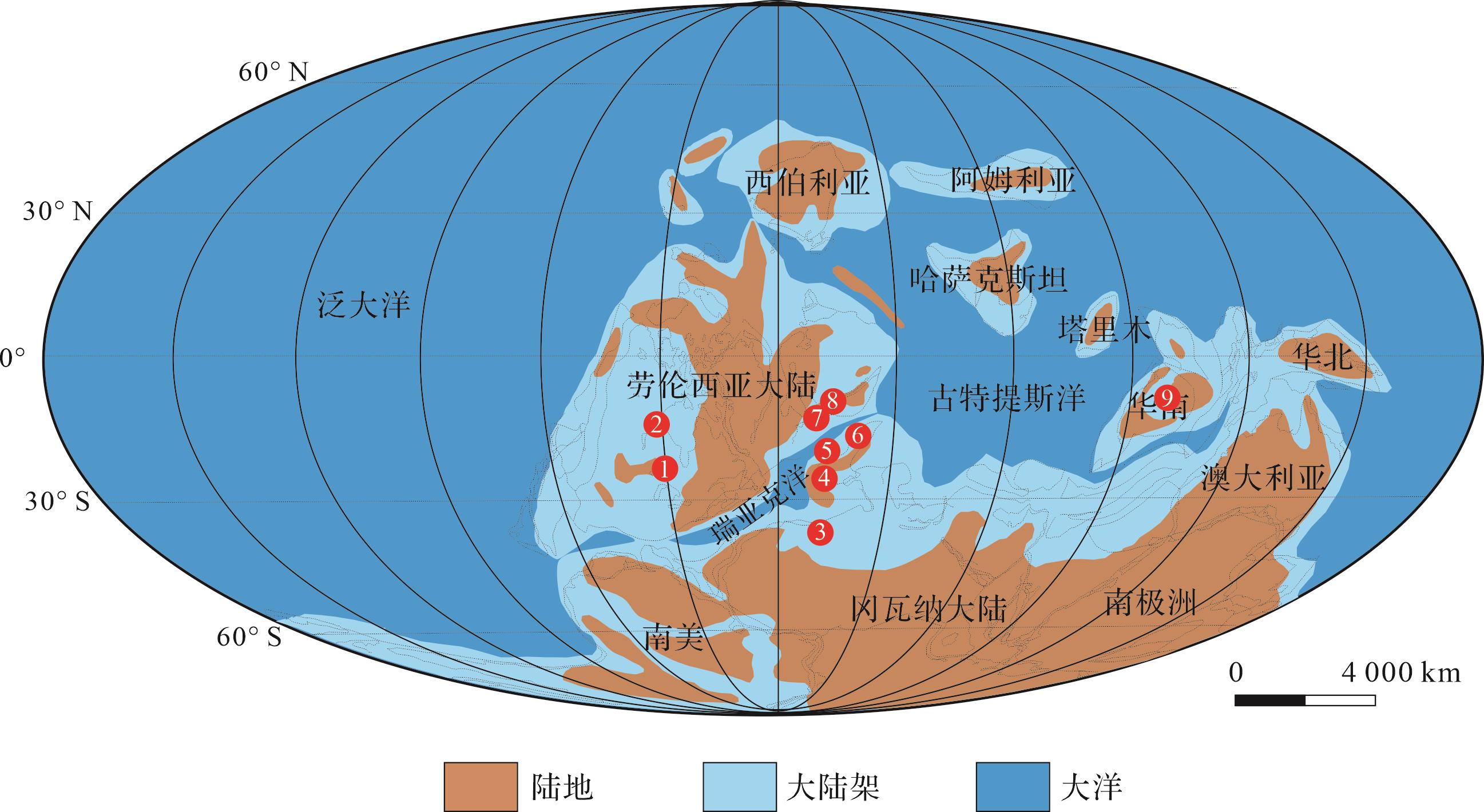





 DownLoad:
DownLoad:
